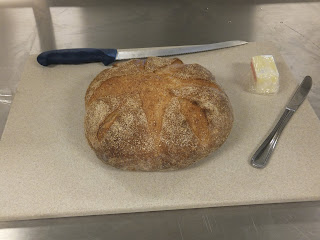I figured that if I baked a familiar loaf well that I could build on that experience and start another string to blog about. The first loaf came out the oven on Monday and was a typical French Country Loaf/ Bauernbrot loaf that I'm fond of baking. One of the endearing qualities of this style of bread is that the flavor improves as the days pass.
The second loaf is a "Rustic Loaf". The original formula was developed by Jeff Hamelman and included in his book, "Bread". The formula was then adapted by FloydM, the site manager for the "Fresh Loaf". Because Floyd used ounces rather than grams, I adapted that formula to grams for my own use by using bakers' math. It wasn't very difficult and my results justified the effort. I brought it to class yesterday.
There are a few notable aspects to the formula. First of all, the preferment used is a "pate fermentee" or "old dough", something that is currently out of favor in the latest bread recipe books. The next thing is that 50% of the total flour is used in the preferment.. Finally, My math called for the use of only 3/8 teaspoon of yeast, if I had used instant dry yeast. I used active dry yeast and stayed with the measurement and as you can see, still got a nice loaf to bring to class. I wanted to show my classmates and the instructors something a little different from the sourdough I brought in earlier. This was a successful effort. I got a loaf with a good crumb where you can actually taste the whole wheat and rye flours. I suspect that if you baked two loaves, one with whole wheat and the other with white whole wheat, you could tell the difference when you otherwise followed ingredients and procedure.
The Rustic Loaf is an ideal bread for the beginner who is ready to take the step into preferments and more complex flavored breads.
Preferment or Pate Fermentee
250 g bread flour
148 g water at 85F
5 g kosher salt
1/8 tsp active dry yeast
This preferment will take 12-14 hours for adequate development at a room temperature around 70F. Plan accordingly.
Main Dough
156 g bread flour
40 g rye flour
54 g whole wheat flour
195 g water at 85F
5 g kosher salt
1/4 tsp active dry yeast.
Due to the low quantity of yeast, this loaf developed only a little faster than a typical sourdough. The bulk fermentation took about three hours with a couple stretch and folds. After shaping, the proofing took about 1 1/2 hrs. If time is available, following the formula will reward you with a fine yeasted loaf
The blooming of our daffodils is being interfered with by the onset of early Spring snowfalls. I can sympathize with the folks who have been posting "Wanted" posters of Punxatawney Phil on the internet. So far, I have had only a single crocus bloom which is disappointing but not that unusual in Kansas. We have a large number of the usual suspects at our bird feeders including many juncos that I expected to have left by now. My garlic is starting to push through the wheat straw that I use as a mulch for the bed.
Visitors to my obscure corner of the internet in past ten days include hits from Belgium, Kazahkstan, Latvia, and Macau.
Comments, humor, and questions are welcome.



No comments:
Post a Comment